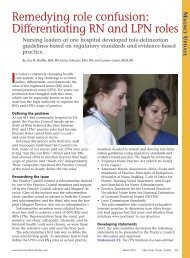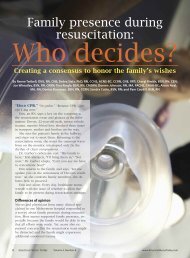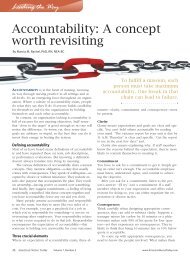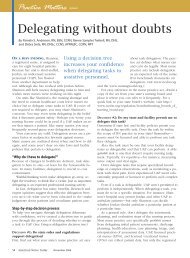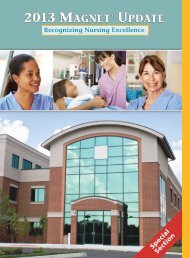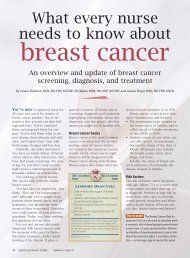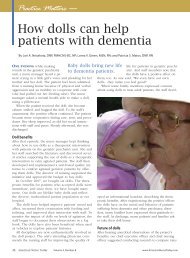2009 MAGNET™ PROFILES - American Nurse Today
2009 MAGNET™ PROFILES - American Nurse Today
2009 MAGNET™ PROFILES - American Nurse Today
You also want an ePaper? Increase the reach of your titles
YUMPU automatically turns print PDFs into web optimized ePapers that Google loves.
MAGNET <strong>PROFILES</strong><br />
from a pat on the back to formal<br />
recognition. Everyone wants to be<br />
recognized for a job well done.<br />
Handwritten notes, letters placed in<br />
employee files with copies sent to<br />
appropriate administrators, and<br />
small tokens of appreciation (such<br />
as gift certificates to the coffee shop)<br />
go a long way toward recognizing<br />
and rewarding good performance.<br />
Many organizations have peerrecognition<br />
activities that include<br />
thank-you-note bulletin boards<br />
where staff members post appreciation<br />
notes to each other.<br />
When necessary, leaders should<br />
provide constructive criticism in a<br />
timely fashion. Along with such<br />
criticism, reinforce your expectations<br />
for the employee. If a staff<br />
member fails to meet these expectations,<br />
convey this conclusion<br />
honestly in a structured performance<br />
appraisal. (The same goes<br />
when an employee meets or exceeds<br />
expectations.) Use your organization’s<br />
performance management<br />
policies to address the<br />
deficiency. Don’t sweep poor performance<br />
under the rug or simply<br />
transfer it to another department.<br />
In addition, invite representatives<br />
of other departments to visit<br />
your unit so they can provide information on their<br />
care processes and outcomes and help staff members<br />
see how the various disciplines can work better<br />
together to improve patient care.<br />
Finally, participate in mock tracer studies to aid<br />
assessment, using leaders from other departments<br />
who can assess your unit’s processes objectively. This<br />
also helps prepare staff to feel comfortable discussing<br />
patient care processes and outcomes with others.<br />
Sample signup sheet for quality-care topics<br />
This sample signup sheet shows potential topics staff nurses may wish to present<br />
for the “quality care” agenda item during monthly unit meetings.<br />
RNs, LPNs: Sign up for<br />
Month Topic your topic of interest<br />
January Preventing bacteremia and UTIs Shelly Alvero<br />
February Pressure ulcer prevalence, incidence, Melissa Shaw<br />
and prevention<br />
March Preventing medication errors Jim Maddison<br />
April Preventing falls Doris Weber<br />
May Culturally competent/sensitive care Rachael Verrango<br />
June Reducing restraint use Chris Davidson<br />
July<br />
August<br />
September<br />
October<br />
November<br />
December<br />
Pain management<br />
Informed consent and operative procedures<br />
Patient education practices<br />
Functional and nutritional screening<br />
Evidence-based practice/quality measures<br />
appropriate for the nursing unit<br />
Advance directives and patient rights<br />
supporting a culture that demonstrates Magnet<br />
principles in daily practice.<br />
Consistently providing the safest and best care<br />
possible isn’t negotiable—but being in continual<br />
compliance isn’t as daunting as it may seem. You<br />
can achieve this goal by exhibiting visionary leadership,<br />
creating a culture of safety and high expectations,<br />
and using effective communication, education,<br />
feedback, and teamwork.<br />
■<br />
A final “E” for excellence<br />
Setting clear expectations, providing staff education,<br />
engaging staff in quality initiatives, and evaluating<br />
outcomes can help your work culture<br />
achieve both continual readiness for surveys and<br />
excellence in performance. A culture of excellence<br />
empowers nurses to create innovative solutions to<br />
help achieve excellent clinical outcomes, which in<br />
turn supports the Magnet principles of the <strong>American</strong><br />
<strong>Nurse</strong>s Credentialing Center. Magnet hospitals<br />
demonstrate better quality, as shown by decreased<br />
patient morbidity and mortality. By maintaining a<br />
laser focus on high standards of patient care, leaders<br />
and their staff can help ensure their units are<br />
complying with regulatory requirements and are<br />
Selected references<br />
Adamski P. Implement a handoff communications approach. Nurs<br />
Manage. 2007;38(1):10,12.<br />
Adamski P. Prepare for the next patient instead of the next survey.<br />
Nurs Manage. 2006;37(11):9.<br />
<strong>American</strong> <strong>Nurse</strong>s Credentialing Center. Announcing a New Model for<br />
ANCC's Magnet Recognition Program. www.nursecredentialing.org/<br />
Magnet/NewMagnetModel.aspx. Accessed August 24, <strong>2009</strong>.<br />
Comeau E, Lowry D. Unannounced JC survey. J Nurs Care Qual.<br />
2005;20(1):5-8.<br />
Gant NR, Sorenson L, Howard RI. A collaborative perspective on<br />
nursing leadership in quality improvement. Nurs Adm Q. 2003;<br />
27(4):324-329.<br />
Barbara C. Sorbello is Administrative Director for Acute Care Services at Bon<br />
Secours-St. Francis Medical Center in Midlothian, Virginia.<br />
66 <strong>American</strong> <strong>Nurse</strong> <strong>Today</strong> Volume 4, Number 8




